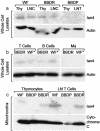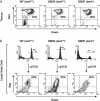Ian4 is required for mitochondrial integrity and T cell survival
- PMID: 12930893
- PMCID: PMC193570
- DOI: 10.1073/pnas.1832170100
Ian4 is required for mitochondrial integrity and T cell survival
Abstract
Apoptosis is a regulated cell death program controlled by extrinsic and intrinsic signaling pathways. The intrinsic pathway involves stress signals that activate pro-apoptotic members of the Bcl-2 family, inducing permeabilization of mitochondria and release of apoptogenic factors. These proteins localize to the outer mitochondrial membrane. Ian4, a mitochondrial outer membrane protein with GTP-binding activity, is normally present in thymocytes, T cells, and B cells. We and others have recently discovered that a mutation in the rat Ian4 gene results in severe T cell lymphopenia that is associated with the expression of autoimmune diabetes. The mechanism by which Ian4 controls T cell homeostasis is unknown. Here we show that the absence of Ian4 in T cells causes mitochondrial dysfunction, increased mitochondrial levels of stress-inducible chaperonins and a leucine-rich protein, and T cell-specific spontaneous apoptosis. T cell activation and caspase 8 inhibition both prevented apoptosis, whereas transfection of T cells with Ian4-specific small interfering RNA recapitulated the apoptotic phenotype. The findings establish Ian4 as a tissue-specific regulator of mitochondrial integrity.
Figures






Similar articles
-
Partial activation precedes apoptotic death in T cells harboring an IAN gene mutation.Eur J Immunol. 2004 Sep;34(9):2396-406. doi: 10.1002/eji.200324751. Eur J Immunol. 2004. PMID: 15307172
-
Cancer-specific toxicity of apoptin is independent of death receptors but involves the loss of mitochondrial membrane potential and the release of mitochondrial cell-death mediators by a Nur77-dependent pathway.J Cell Sci. 2005 Oct 1;118(Pt 19):4485-93. doi: 10.1242/jcs.02580. J Cell Sci. 2005. PMID: 16179607
-
Toxic proteins released from mitochondria in cell death.Oncogene. 2004 Apr 12;23(16):2861-74. doi: 10.1038/sj.onc.1207523. Oncogene. 2004. PMID: 15077149 Review.
-
Antizyme, a natural ornithine decarboxylase inhibitor, induces apoptosis of haematopoietic cells through mitochondrial membrane depolarization and caspases' cascade.Apoptosis. 2006 Oct;11(10):1773-88. doi: 10.1007/s10495-006-9512-2. Apoptosis. 2006. PMID: 16927018
-
[Mitochondrial dynamics regulated by fusion and fission].Tanpakushitsu Kakusan Koso. 2005 Jul;50(8):931-9. Tanpakushitsu Kakusan Koso. 2005. PMID: 16001798 Review. Japanese. No abstract available.
Cited by
-
Preoperative lymphopaenia, mortality, and morbidity after elective surgery: systematic review and meta-analysis.Br J Anaesth. 2021 Jul;127(1):32-40. doi: 10.1016/j.bja.2021.02.023. Epub 2021 Mar 29. Br J Anaesth. 2021. PMID: 33795133 Free PMC article.
-
Purification, crystallization and preliminary X-ray analysis of human GIMAP2.Acta Crystallogr Sect F Struct Biol Cryst Commun. 2010 Jun 1;66(Pt 6):725-9. doi: 10.1107/S174430911001537X. Epub 2010 May 29. Acta Crystallogr Sect F Struct Biol Cryst Commun. 2010. PMID: 20516611 Free PMC article.
-
IAN/GIMAPs are conserved and novel regulators in vertebrates and angiosperm plants.Plant Signal Behav. 2009 Mar;4(3):165-7. doi: 10.4161/psb.4.3.7722. Plant Signal Behav. 2009. PMID: 19721741 Free PMC article. Review.
-
Mitochondrial Reactive Oxygen Species and Type 1 Diabetes.Antioxid Redox Signal. 2018 Nov 10;29(14):1361-1372. doi: 10.1089/ars.2017.7346. Epub 2018 Feb 15. Antioxid Redox Signal. 2018. PMID: 29295631 Free PMC article. Review.
-
Modulation of the diet and gastrointestinal microbiota normalizes systemic inflammation and β-cell chemokine expression associated with autoimmune diabetes susceptibility.PLoS One. 2018 Jan 2;13(1):e0190351. doi: 10.1371/journal.pone.0190351. eCollection 2018. PLoS One. 2018. PMID: 29293587 Free PMC article.
References
Publication types
MeSH terms
Substances
Grants and funding
LinkOut - more resources
Full Text Sources
Molecular Biology Databases

